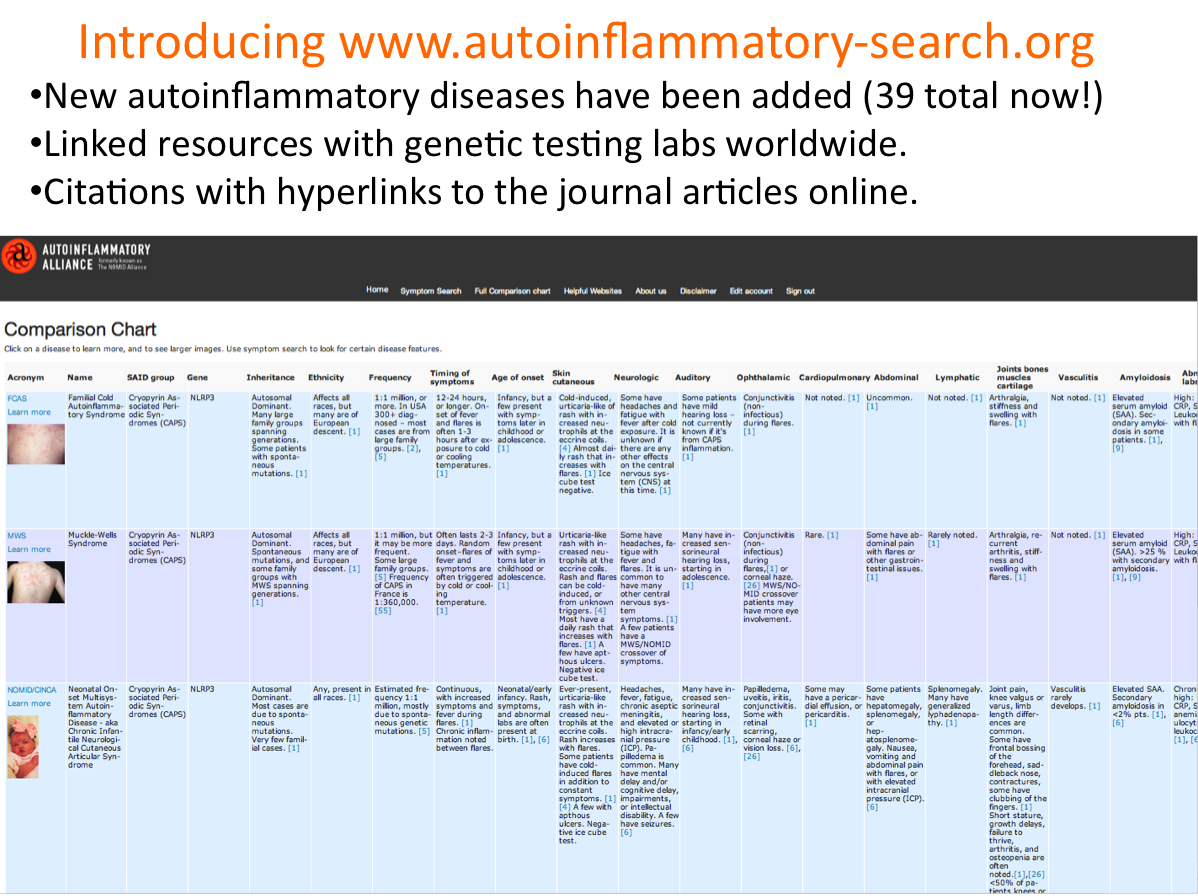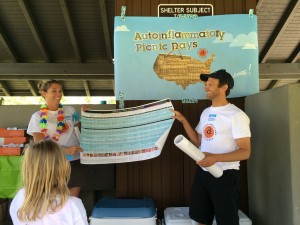Below are links to Familial Mediterranean Fever (FMF) studies and other helpful information. These are not all the studies available however. For more search Pubmed.gov.
Click here to see studies relating to single mutation FMF.
EULAR recommendations for the management of familiar Mediterranean fever – Current consensus for FMF treatment recommendations from leading global experts on FMF. Includes detailed information on colchicine dosing.
Familial Mediterranean fever – A review – A good comprehensive review that covers symptoms, diagnosis, and disease management.
Mayo Clinic: Familial Mediterranean Fever – A good simplified overview.
National Institutes of Health: Familial Mediterranean Fever – Another simple overview.
DermNet NZ: Familial Mediterranean Fever – A more detailed overview of FMF. Good overview of symptoms and details on skin involvement in FMF with photos.
Relationship between clinical findings and genetic mutations in patients with familial Mediterranean fever – A comprehensive study that documented symptoms of over 500 children in relation to the FMF mutations. This study concluded:
In summary, the frequency of FMF was 52.8 %. Fever was the most frequent symptom. The most common mutation was M694V. The mean age of patients who were admitted with abdominal pain alone was significantly higher than patients who presented with fever alone. Abdominal pain was significantly more frequent in patients with M694V and E148Q heterozygous mutations than children with R202Q and M680I heterozygous mutations. Arthritis/arthralgia were significantly more common in patients with homozygous M694V and E148Q mutations. Chest pain was more frequent with homozygous M694V (61.4 %) and heterozygous E148Q (25.6 %) mutations (p = 0.04). In 25 of the 229 children (10.9 %) with chest pain, pericardial effusion was documented at echocardiography. Skin eruption was most commonly seen in homozygous E148Q mutations. This was followed by heterozygous M694V and heterozygous M680I mutations. Homozygous M694V (n = 34, 32.3 %) and E148Q (n = 23, 22 %) mutations were significantly more frequent in patients with HSP (p = 0.03). Arthritis (n = 17, 7.0 %) and arthralgia (n = 24, 6.7 %) were seen more frequently in patients with compound heterozygous M694V/E148Q mutations, whereas M694V/R202Q coexistence caused skin eruptions (n = 16, 11.4 %) more frequently. The most frequent occurence of febrile episodes were in patients with M694V homozygous mutations (number of attacks = 4.4 ± 1.6/month). Patients with a history of appendectomy (n = 26) carried homozygous M694V (n = 16) and E148Q (n = 10) mutations. Diarrhea developed after colchicine therapy in 0.22 % of patients. The ratio of the clinically-severe patients was 24.1 % (n = 70) in children with homozygous M694V mutations. This ratio was significantly higher than other homozygous mutations. Proteinuria was detected most frequently in patients with homozygous M694V mutations. The SAA level in homozygous M694V mutations was significantly higher than in other mutations.
Primary headaches in pediatric patients with chronic rheumatic disease – “Patients with JIA and FMF should be asked specifically about accompanying primary headaches particularly migraine headaches as they may be additional disabilities for these patients.”
Functional gastrointestinal disorders in patients with familial Mediterranean fever – “IBS and dyspepsia were not increased in patients with FMF, whereas diarrhoea was more frequently reported.”
MEFV gene mutations and cardiac phenotype in children with familial Mediterranean fever: a cohort study. – “In our cohort of children with FMF, cardiac involvement appears to be common. Pericardial effusions are significantly related to presence of mutation types E48Q, P 369S, V726A. These associations may warrant genetic screening of children with FMF to detect cardiac risk.”
Colchicine-induced lactose malabsorption in patients with familial Mediterranean fever –Colchicine, the common treatment for FMF, is known to cause lactose intolerance.
Relationship of Tel Hashomer criteria and Mediterranean fever gene mutations in a cohort of Turkish familial Mediterranean fever patients – “In patients with high or low clinical suspicion of diagnosis of FMF according to Tel Hashomer criteria, the frequency of homozygote patients was significantly higher than the frequency of patients with no mutation, but it was not higher than the frequency of heterozygote patients.”
Recent Advances in Children With Familial Mediterranean Fever: Diagnosis – dated 3/28/2013 Includes 3 different criteria used to diagnose FMF.
Decreased vitamin D levels in children with familial Mediterranean fever – “Cumulative colchicine dose appears to negatively affect vitamin D levels.”
Thyroid autoimmunity in patients with Familial Mediterranean Fever: preliminary results – “Although statistically not significant, thyroid autoimmunity was observed more frequently in patients with FMF than in healthy controls.”
Cutaneous necrotizing vasculitis as a manifestation of familial Mediterranean fever – “Cutaneous necrotizing vasculitis repeatedly emerging with febrile attacks should be included among the skin manifestations of FMF.”





